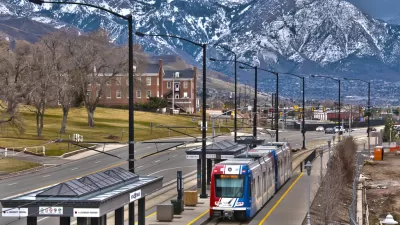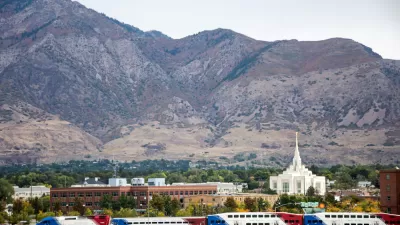The Rio Grande Plan would restore rail service to the Rio Grande Depot and reconnect a community divided by a freeway in Salt Lake City.
A pair of private citizens with engineering and design backgrounds have proposed a plan, called the Rio Grande Plan, to improve transit service and reduce freeway impacts in Salt Lake City.
An article by Benjamin Wood introduces the Rio Grande Plan, which has been gaining support among local politicians.
The idea is the brainchild of Charles Lenhart, and engineer, who experienced frustration with transfers between Trax and Frontrunner trains in 2020. “[A]fter studying successful rail rehabilitation projects around the country, he prepared a 60-page draft proposal calling for a so-called ‘train box’ along 500 West that would move freight and passenger lines underground and reactivate the historic Rio Grande Depot as a bonafide transportation hub,” writes Wood.
"The more I thought about it and looked at the grades going into the structure and going out, and how much land would actually be opened up and the way you could reduce the freeway impacts downtown, it started to seem so obvious that yes, this is the right thing to do," Lenhart is quoted as saying in the article.
After teaming up with Cameron Blakely, a designer, after posting the idea on an unnamed “message board for urban planning enthusiasts,” the duo created the final Rio Grande Plan, which is available to explore online.
Wood also reports that “while the Salt Lake City Council hasn't formally supported the plan, the city has twice applied for grant funding to study the proposal, most recently in a ‘Reconnecting Communities’ application that would explore various ways to mitigate the division between the city's east and west sides.”
FULL STORY: Two Salt Lakers have a next-generation plan for transit that, just maybe, could save downtown

Planetizen Federal Action Tracker
A weekly monitor of how Trump’s orders and actions are impacting planners and planning in America.

Map: Where Senate Republicans Want to Sell Your Public Lands
For public land advocates, the Senate Republicans’ proposal to sell millions of acres of public land in the West is “the biggest fight of their careers.”

Restaurant Patios Were a Pandemic Win — Why Were They so Hard to Keep?
Social distancing requirements and changes in travel patterns prompted cities to pilot new uses for street and sidewalk space. Then it got complicated.

Platform Pilsner: Vancouver Transit Agency Releases... a Beer?
TransLink will receive a portion of every sale of the four-pack.

Toronto Weighs Cheaper Transit, Parking Hikes for Major Events
Special event rates would take effect during large festivals, sports games and concerts to ‘discourage driving, manage congestion and free up space for transit.”

Berlin to Consider Car-Free Zone Larger Than Manhattan
The area bound by the 22-mile Ringbahn would still allow 12 uses of a private automobile per year per person, and several other exemptions.
Urban Design for Planners 1: Software Tools
This six-course series explores essential urban design concepts using open source software and equips planners with the tools they need to participate fully in the urban design process.
Planning for Universal Design
Learn the tools for implementing Universal Design in planning regulations.
Heyer Gruel & Associates PA
JM Goldson LLC
Custer County Colorado
City of Camden Redevelopment Agency
City of Astoria
Transportation Research & Education Center (TREC) at Portland State University
Camden Redevelopment Agency
City of Claremont
Municipality of Princeton (NJ)





























